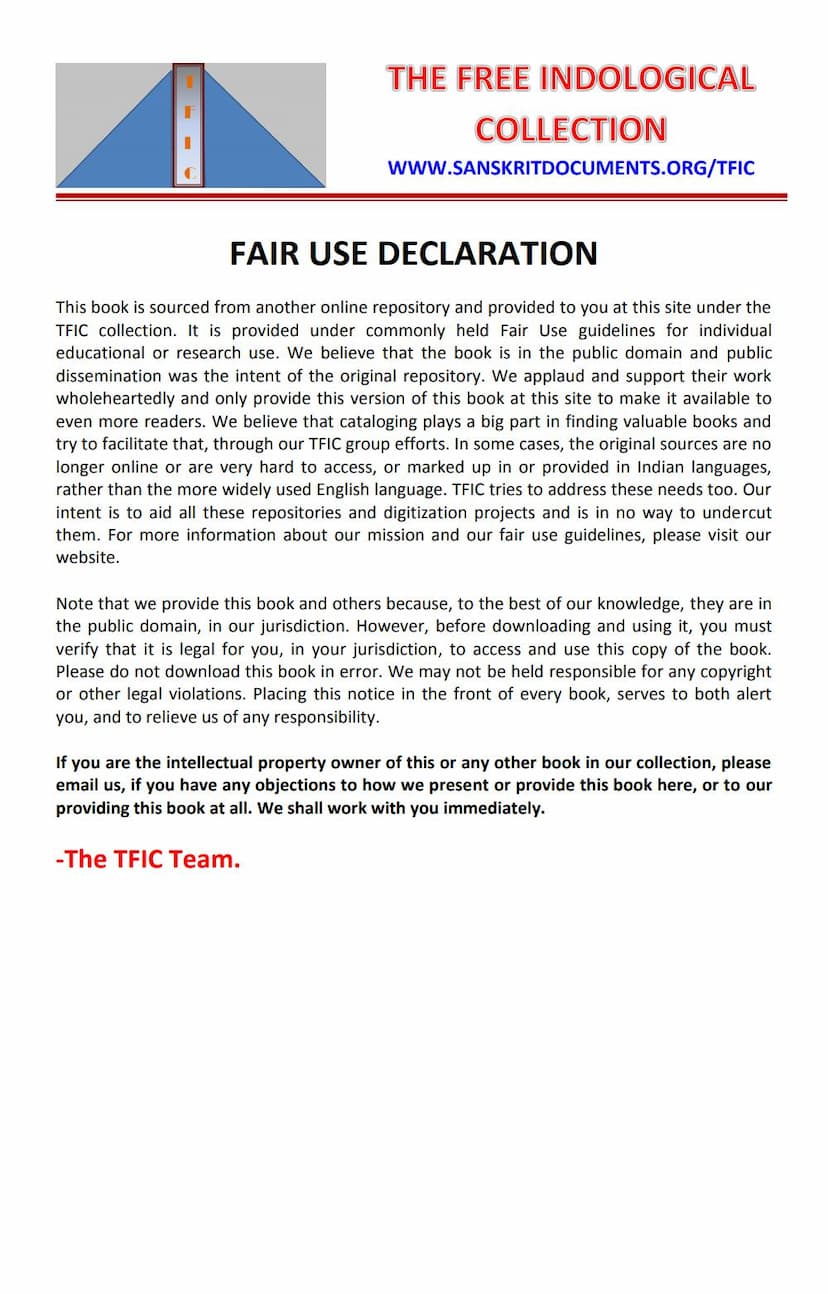Bhagvad Gita Rahasya Or Karmayoga Shastra VOL 02
Added to library: September 1, 2025

Summary
Here's a comprehensive summary of the provided Jain text, focusing on Volume II of "Bhagavad Gita Rahasya or Karmayoga Shastra" by Bal Gangadhar Tilak, translated by Bhalchandra S Sukthankar:
Overall Nature of the Work:
This document is Volume II of an English translation of Bal Gangadhar Tilak's seminal work, "Bhagavad Gita Rahasya or Karmayoga Shastra." The original work, authored by the influential Indian nationalist leader and scholar B.G. Tilak, presents a detailed philosophical and ethical interpretation of the Bhagavad Gita, emphasizing its message of Karma Yoga (the Yoga of Action). This volume, translated by B.S. Sukthankar, aims to make Tilak's profound analysis accessible to an English-speaking audience.
Key Themes and Content of Volume II:
Volume II of the Gita Rahasya, as indicated by its detailed table of contents, delves deeply into the philosophical underpinnings of the Bhagavad Gita, continuing from Volume I. The overarching theme remains the advocacy of Karma Yoga as the highest and most practical path for human existence.
The volume is structured to provide a comprehensive understanding of the Gita's teachings through:
-
Analysis of the Gita's Chapters: The detailed table of contents outlines the thematic progression of each chapter of the Bhagavad Gita, from Chapter XIV to Chapter XVIII. Each chapter is broken down into its core subject matter, providing a roadmap of the philosophical arguments presented.
- Chapter XIV: The Continuity of the Chapters of the Gita (Gītādhyāya-Saṁgati): This chapter likely focuses on the logical flow and interconnectedness of the Gita's teachings, demonstrating how the different chapters build upon each other to establish the central doctrine of Karma Yoga. It argues against a fragmented understanding of the Gita.
- Chapter XV: Conclusion (Upasaṁhāra): This chapter serves as a résumé, summarizing the entire philosophical exposition. It likely reiterates the core message of Karma Yoga, its ethical implications, and its harmony with spiritual knowledge and devotion. It may also include comparisons with Western philosophical and ethical doctrines.
- Appendices: A significant portion of Volume II is dedicated to extensive appendices that undertake an "External Examination of the Bhagavad Gita." These appendices are crucial for understanding Tilak's scholarly approach and his defense of the Gita's historical and philosophical integrity. The appendices cover:
- Part I: The Gita and the Mahabharata: Argues for the Gita's integral inclusion within the Mahabharata, demonstrating textual and linguistic similarities to prove a common authorship and refuting claims of interpolation.
- Part II: The Gita and the Upanishads: Explores the Upanishadic influences on the Gita's Vedantic knowledge, noting similarities and differences, particularly in the Gita's integration of Sāmkhya and devotional aspects.
- Part III: The Gita and the Brahma-Sutras: Analyzes the relationship between the Gita and the Brahma-Sutras, addressing chronological questions and the significance of references between the two texts.
- Part IV: The Rise of the Bhagavata Religion and the Gita: Traces the historical development of the Bhagavata religion and argues for its connection with the Gita, proposing a date for Sri Krishna and the promulgation of this religion.
- Part V: The Date of the Present Gita: Offers a scholarly attempt to establish the historical dating of the Bhagavad Gita, drawing upon various internal and external evidence, including linguistic analysis, references in other ancient texts, and astronomical calculations.
- Part VI: The Gita and Buddhistic Literature: Examines the similarities and differences between the Gita's teachings and Buddhist philosophy, particularly regarding concepts of renunciation, ethical conduct, and the nature of the self. It also discusses the potential influence of the Gita on Mahayana Buddhism.
- Part VII: The Gita and the Christian Bible: Addresses claims of similarity between the Gita and Christian scriptures, arguing for the antiquity of Indian traditions and the potential influence of Indian thought on early Christianity.
-
Original Stanzas of the Gita with Translation and Commentary: Following the appendices, the volume presents the original Sanskrit stanzas of the Bhagavad Gita, accompanied by an English translation and a detailed commentary. This section aims to elucidate the meaning of each verse, connecting it to Tilak's broader arguments and philosophical interpretations. The commentary often draws upon other ancient Indian texts, providing context and justification for Tilak's views.
-
Author's Preface: Provides insights into Tilak's intention and methodology in presenting the Gita Rahasya, highlighting the importance of Karma Yoga and the fusion of knowledge, devotion, and action.
-
Prominent Personalities on the Gita: The volume includes commendatory statements from notable figures of the time, such as Shrimant Balasaheb Pant Pratinidhi, Justice Faiz B. Tyabji, Sir Mohammad Iqbal, Sri Meher Baba, and C.V. Vaidya, underscoring the profound impact and universal appeal of the Bhagavad Gita and Tilak's interpretation.
Tilak's Core Argument for Karma Yoga:
Tilak's central thesis, likely elaborated throughout this volume, is that the Bhagavad Gita advocates for an active engagement with life, rather than mere renunciation. He argues that true spiritual fulfillment is achieved by performing one's prescribed duties with detachment from the fruits of action, dedicating the actions to the Divine, and cultivating an equable state of mind. This active participation in the world, guided by knowledge and devotion, is presented as the most effective path to both individual liberation and societal well-being.
Scholarly Rigor and Methodology:
The work is characterized by its immense scholarly rigor. Tilak and Sukthankar engage with a vast array of Sanskrit texts, including the Vedas, Upanishads, Smritis, Purānas, and other philosophical schools like Sāmkhya and Mimāṁsā. The appendices, in particular, demonstrate a meticulous approach to historical and textual criticism, aiming to establish the Gita's authenticity, its place within the Mahabharata, and its chronological context.
In essence, Volume II of "Bhagavad Gita Rahasya" is a profound philosophical exploration that seeks to establish Karma Yoga as the supreme path to spiritual realization and societal harmony, drawing upon the entirety of ancient Indian wisdom and presenting it with rigorous scholarly analysis.